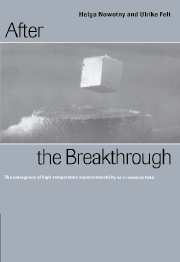Book contents
- Frontmatter
- Contents
- Acknowledgments
- 1 Introduction: the emergence of a new research field
- 2 The context of the discovery
- 3 Reconfiguring actors and knowledge: the organization of a new research field
- 4 Academic research, science policy, and the industrial connection: setting up national high-temperature superconductivity programs
- 5 Science and the media: newspapers and their “HTS story”
- 6 The innovation machinery of science: the case of HTS
- Appendix 1 Main events in the history of superconductivity before the discovery by Müller and Bednorz
- Appendix 2 Chronology of important events in high-temperature superconductivity in the early phase
- References
- Index
6 - The innovation machinery of science: the case of HTS
Published online by Cambridge University Press: 02 December 2009
- Frontmatter
- Contents
- Acknowledgments
- 1 Introduction: the emergence of a new research field
- 2 The context of the discovery
- 3 Reconfiguring actors and knowledge: the organization of a new research field
- 4 Academic research, science policy, and the industrial connection: setting up national high-temperature superconductivity programs
- 5 Science and the media: newspapers and their “HTS story”
- 6 The innovation machinery of science: the case of HTS
- Appendix 1 Main events in the history of superconductivity before the discovery by Müller and Bednorz
- Appendix 2 Chronology of important events in high-temperature superconductivity in the early phase
- References
- Index
Summary
Many observers agree that science is currently passing through a period of dramatic transformation. At the end of his lucid analysis of science in a dynamic steady state, John Ziman concludes that there is no way back to the traditional habits of managing research, but there is also no obvious path forward to a cultural plateau of comparable stability.
The new structures that are emerging are not the products of a gentle process of evolution: they are being shaped very roughly by a dynamic balance between external forces exerted by society at large and internal pressures intrinsic to science itself
(Ziman, 1994: 250).We believe that the emergence of HTS sheds light on what these forces are and how they interact. In the beginning of this book, we compared the effects of the discovery of HTS on the research system to a building tested by being subjected to a transient load which reveals otherwise hidden strengths and weaknesses. Indeed, HTS can be seen as a case that shows how complex and fluid the present situation has become. Researchers can no longer expect to find an environment hospitable to their work, but are compelled to create one. We have seen that it takes extraordinary effort, time, and energy to set up the conditions under which research programs can run for a predictable period. Such efforts are no longer external to, but have become an integral feature of scientists' work. Nor are they limited to the small research group institutionally at home at the university.
The situation is also extremely fluid on the level of policy-making.
- Type
- Chapter
- Information
- After the BreakthroughThe Emergence of High-Temperature Superconductivity as a Research Field, pp. 160 - 193Publisher: Cambridge University PressPrint publication year: 1997



